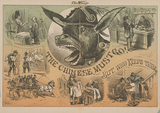
After the Philippine-American War ended in 1902, Americans became fascinated by the natives of the newly acquired territory, which led to the development of anthropological exhibits showcasing what “primitive” life was like in the Philippines. During this time period, anthropologists adopted an evolutionary perspective rooted in white superiority. One of the exhibits featured the Igorot people, who anthropologist Albert Jenks believed were the most uncivilized tribe in the Philippines. These exhibits/human zoos sparked the creation of negative stereotypes of both the Igorot people and the Filipino community. Students will view the video segment from Asian Americans and engage in activities and discussions to explore the power of perception and its impact on shaping the identities of Asian Americans. Students will also examine the U.S. politics and scientific theories that shaped the perception of Americans and sought to justify U.S. colonization in the Pacific and the mistreatment of the Filipino community.
2021 Social Science Standards Integrated with Ethnic Studies:
Civics and Government: HS.2, HS.9
Historical Knowledge: 5.22, 6.20, 6.21, 8.22, 8.25, HS.52, HS.63, HS.64
Historical Thinking: 5.24, 7.25, 8.31, HS.67, HS.70
Social Science Analysis: 5.26, 5.27, 6.24, 7.27, 8.33, 8.34, 8.36, HS.72, HS.73, HS.74, HS.78
- Subject:
- English Language Arts
- History
- U.S. History
- Material Type:
- Lesson Plan
- Author:
- The Asian American Education Project
- Date Added:
- 02/02/2023


















